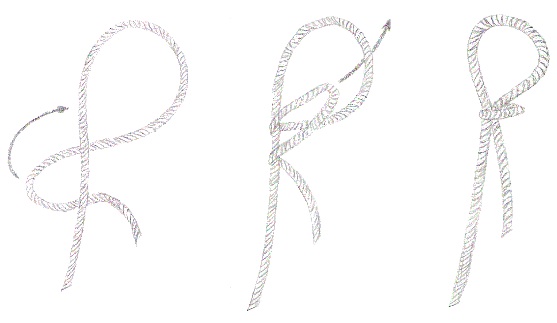Loom Knitting Glossary
Like needle knitting, loom knitting uses many
different terms. Most of them are the same as needle
knitting but a few are specific to loom knitting. Click
once each entry below to display the definition of the
term, click another time to close the entry. If there
is a term that you would like to see included or a term
that you feel should be modified, please feel free to
contact me.
Click on each term below to display its definition.
Used in knitting board knitting. A piece of yarn that is three-to-four times the length of the knitted project placed over the cast-on stitches of the project and is not connected to the project. To keep the anchor yarn from dangling, it is recommended that you tie it below the knitting. There are two reasons why you use an anchor yarn on the knitting board:
- To assist in pulling down the first few
rows of knitting
- To keep the cast-on stitches secure until you finish the edge after binding-off
The anchor peg, or holding peg, is the peg or tack on the side of the round loom, rake or knitting board. Use this peg to anchor your yarn when you cast-on or after wrapping a row.
Binding off means to knot or stitch off by looping. Binding off is the act of looping the entire project or several stitches off of the loom. Binding off is sometimes called casting off. There are several different methods for binding off depending on project. These include:
- Round Loom & Rake
- Knitting Board
- Knit
- Purl
- Single Chain
See Binding Off.
Casting means to make a knot or stitch by looping. Casting on is the act of initially looping the yarn onto the loom. There are several different methods for casting on depending on the project. These include:
- Round Loom & Rake
- Knitting Board
- E-wrap stockinette
- Long tail
- Lucet
- Stockinette
- Twisted
Circular Knitting is a method of knitting in a
circle around a round loom. The types of items that
you would knit this way include hats, bags, purses,
balls, mittens and socks.
E-wrap is a way to wrap each peg so that it
forms an upside down cursive "e" when looking
straight down on the loom. It is also known as the
twisted knit stitch or knit through the back loop
stitch. The e-wrap stitch is the most common stitch
in loom knitting unlike needle knitting where the
most common stitch is the knit stitch.
Felting is the process of making a project made
of at least 80% wool yarn and shrinking it so that
it becomes a matted material that is firmer,
stronger and warmer than the original project.
Knitting a simple purse and felting it is a great
way to get started in knitting: if you make a
knitting mistake, it won't show in the final
project!
Flat Knit, not to be confused with the
flat stitch, is a method of
knitting a flat piece on a loom such as a
blanket, scarf, afghan, purse, etc. It is also
known as Flat Panel knitting.
Flat Panel is a method of knitting a flat piece
on a loom such as a blanket, scarf, afghan, purse,
etc. It is also known as Flat Knit knitting.
Frogging is unraveling the knitting that you
have done. And easy way to remember this term is to
think about the sound a frog makes (rib-bit rib-bit
for rip-it rip-it). The actual etymology of the
word is unclear. There are two possibilities for
its origin:
- The croak of a frog
- The resemblance to frogging (looped ornamental braid) to the loops of yarn of the unraveled garment
The holding peg, or anchor peg, is the peg or
tack on the side of the round loom, rake or
knitting board. Use this peg to anchor your yarn
after wrapping a row.
Knitting off refers to a single stitch (as
opposed to binding off which can refer to an entire
project). Knitting off moves a loop either over or
behind the loom peg. For example, in an e-wrap stitch, you knit off
by moving the bottom loop over the top loop.
For the purl stitch, you knit off by
moving the top stitch behind the peg when you
place the newly formed loop onto the peg.
Please see each stitch for complete
instructions.
A knitting tool is a pick you use to knit off
the yarn on a loom. Knitting tools can be made by
loom companies, dental tools, nut picks, O-ring
tools, etc. Find the tool that works best for you
and use it!
A slip knot is a knot that creates an adjustable
loop. Normally, the first wrap placed on the peg on
the loom will be a slip knot. The following diagram
shows how to create one.

Picture from Loom Knitting Glossary
As with everything in knitting, there are many different ways to make a slip knot. The directions below are the way that Vogue Knitting suggests. If you have problems making a slip knot, you can't miss with these directions!
- Hold the tail end of your yarn in the palm of your hand with your thumb. Leave at least 3-inches of tail from the point of your thumb.
- Wrap the yarn around your index and middle fingers (the two next to the thumb) so there is a complete wrap.
- Pull the yarn attached to the skein through the loop between your fingers making a new loop.
- Place the new loop on the first peg of the cast-on. Make sure to leave at least a 3-inch tail.
A stitch that is not knitted. On a round loom or
rake, this is a peg that is only wrapped once and
the yarn for the second wrap is put straight across
the back (slip wyib) or across the front (slip
wyif) and the next peg is wrapped. That peg is not
knit off until the following row.
Merriam Webster defines a stitch as:
- A single loop of thread or yarn around an implement (as a knitting needle or crochet hook).
- A stitch or series of stitches formed in a particular way.
On the loom, the "loop" is not a stitch but a
possible stitch. It does not become a stitch
until it is knit off. On this site, we refer to
that "loop" as a wrap. Names of some series of
stitches that you may be familiar with are
stockinette, garter, and seed.
The current strand (or strands when knitting
with multiple yarns at once) of yarn that is being
used in the knitting coming from the skein. When
working with colors, you may have several working
yarns in use.






